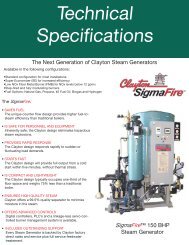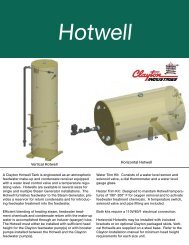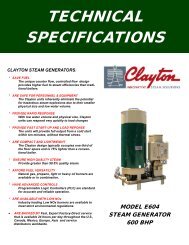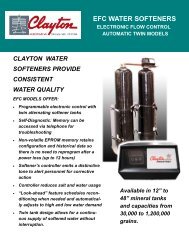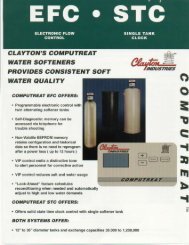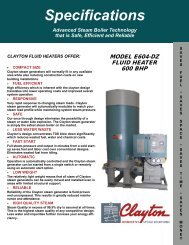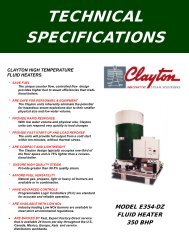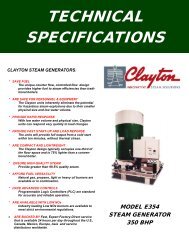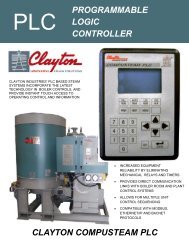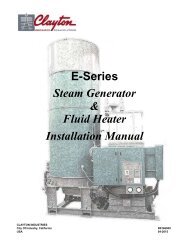SigmaFire Installation Manual, rev. F - Clayton Industries
SigmaFire Installation Manual, rev. F - Clayton Industries
SigmaFire Installation Manual, rev. F - Clayton Industries
You also want an ePaper? Increase the reach of your titles
YUMPU automatically turns print PDFs into web optimized ePapers that Google loves.
SECTION V - TRAPSEPARATORS5.1 GENERAL<strong>Clayton</strong> Steam Generators require the same basic boiler feedwater treatment as any other watertubeor firetube boiler. All require soft water with little or no dissolved oxygen, a sludge conditioner, anda moderate to high pH. The water supplied from the Condensate Receiver should meet these conditions.The primary distinction between a <strong>Clayton</strong> Steam Generator and drum type boiler is how andwhere the desired pH levels are achieved. The feedwater in the Feedwater Receiver is boiler water for the<strong>Clayton</strong> but similar to makeup water for the drum type boiler. Conventional boilers concentrate the boilerfeedwater in the drum and maintain total dissolved solids (TDS) levels and pH through blowdown. A systemconsisting of only <strong>Clayton</strong> Steam Generators uses the Feedwater Receiver much the same way conventionalboilers use drums except that blowdown is taken off the separator trap discharge. Typically,drum type boilers cannot tolerate the higher pH levels that must be maintained in the Feedwater Receiverto satisfy <strong>Clayton</strong> feedwater requirements. Both systems work well independently, however feedwaterchemical treatment problems arise when the two are operated in tandem with a common feedwaterreceiver - <strong>Clayton</strong>(s) with conventional boiler(s).The <strong>Clayton</strong> Trap Separator was designed to remedy the boiler compatibility problem. Using aTrap Separator allows both the <strong>Clayton</strong>(s) and conventional boiler(s) to operate together while sharingthe same Feedwater Receiver. Each system receives feedwater properly treated to suit its respectiveoperating requirements. If a Trap Separator is not used, pH is either too high for the conventionalboiler(s) or too low for the <strong>Clayton</strong>(s).5.2 OPERATIONThe separator trap returns from the <strong>Clayton</strong> Steam Generator(s) contain a high concentration ofTotal Dissolved Solids (TDS). This high concentration of TDS is undesirable to conventional boilersbecause the blowdown rate would have to be increased (and could not be increased enough if the feedwaterTDS level was over 3000 ppm). By routing the separator trap returns to the Trap Separator, rather thanto the common Feedwater Receiver, the high concentration of TDS in the trap returns is isolated to the<strong>Clayton</strong> system. This not only eliminates the conventional boiler blowdown problems, but also satisfiesthe higher pH requirement of the <strong>Clayton</strong>(s) Feedwater. The construction of a Trap Separator is very similarto that of a Blowdown Tank. Separator trap return enters tangentially creating a swirling action. Flashsteam is vented out the top and low pressure condensate is fed to the Booster Pump(s) from the outlet.This relatively small amount of concentrated water blends with the larger volume of less concentratedfeedwater being supplied from the Feedwater Receiver (ideally, the chemical treatment for bothsystems is injected into the Feedwater Receiver) to produce a mixture of properly treated feedwater enteringthe <strong>Clayton</strong> Heating Coil(s). The other boiler(s) receive feedwater containing the pH and TDS levelsthey require.04/22/2015 5-1 Sect05_TrapSeparator_SF_e.fm



